Overview
Pipettes and tips serve as indispensable tools within pharmaceutical laboratories, playing a vital role in ensuring the precision and accuracy required for drug formulation and quality control processes. Their careful selection and utilization of high-quality pipettes and tips are paramount; doing so can significantly minimize measurement errors and bolster the reliability of experimental results. This underscores their critical importance in upholding data integrity across the industry. Ultimately, the reliance on superior instruments is not merely a recommendation but a necessity for maintaining the highest standards of scientific excellence.
Introduction
In the dynamic realm of pharmaceutical laboratories, the precision of liquid handling tools, such as pipettes and their tips, plays a pivotal role in ensuring the accuracy of experimental outcomes. The increasing demand for high-quality pipetting solutions is driven by the necessity for reliable data in drug formulation and quality control processes. As the industry evolves, laboratories are increasingly turning to innovative pipette designs and eco-friendly materials, spurred by advancements in technology and a growing emphasis on sustainability. This article delves into the critical importance of pipettes and tips, exploring their various types, best practices, and the latest trends shaping the future of pipetting technology in the pharmaceutical sector.
The Crucial Role of Pipettes and Tips in Pharmaceutical Laboratories
Pipettes and tips are indispensable instruments in pharmaceutical laboratories, facilitating the precise measurement and transfer of liquids. Their accuracy is crucial, directly influencing experimental outcomes and making them essential for processes such as drug formulation and quality control. In an industry where precision is paramount, the selection of pipette and tips can significantly affect the reliability of results.
Utilizing high-quality pipettes and tips markedly reduces the potential for errors, instilling confidence in researchers regarding their data. The capability to accurately manage small volumes is particularly vital in pharmaceutical research, where even minor discrepancies can result in substantial variations in outcomes. Recent advancements in liquid handling technology have further improved their performance, with innovations aimed at enhancing accuracy and user-friendliness. Statistics reveal that a significant number of researchers prioritize the accuracy of these tools in their experimental setups.
Market data indicates that the Pipettes And Pipettors Market has experienced steady growth from 2019 to 2023, underscoring the increasing reliance on these instruments in research environments. Moreover, the integration of Karl Fischer titration methods, particularly through the use of Hiranuma Aquacounter AQV-300 Volumetric and AQ-300 Coulometric titrators from JM Science, is critical in drug and medicine testing, ensuring compliance with the Japanese Pharmacopoeia. These titrators enhance the accuracy of moisture content analysis in pharmaceuticals, which is vital for maintaining product quality and efficacy. The suitability tests for drugs and medicines conducted with these titrators are essential for confirming that pharmaceutical products adhere to stringent quality standards.
Expert opinions consistently underscore the importance of pipettes and tips in safeguarding the integrity of drug formulation and quality control processes. Jared Wan, a Global Product, Quality & Strategy Executive, emphasizes this by stating, "Your perseverance, support, and prompt responses were noted. Happy with the final report and post-sales by your team."
This reinforces the idea that the accurate use of pipettes and tips, coupled with reliable titration methods, is foundational in the pharmaceutical sector. Furthermore, comprehending regional market dynamics across North America, South America, Asia-Pacific, the Middle East, Africa, and Europe can yield valuable insights into the diverse applications and innovations in pipette technology, ultimately enhancing the effectiveness of pharmaceutical research.
Exploring Different Types of Pipette Tips and Their Applications
Pipettes and tips are essential accessories in research environments, available in various types tailored for specific applications. The most common categories include:
- Standard recommendations
- Low-retention designs
- Filter options
Standard recommendations are versatile and suitable for a wide array of applications, establishing them as staples in numerous laboratories.
In contrast, low-retention designs are meticulously engineered to reduce liquid loss, particularly advantageous when handling viscous or volatile liquids. This design feature significantly enhances the accuracy of pipetting, especially in assays that necessitate precise measurements of minimal sample volumes.
Filter devices play a critical role in preventing contamination by blocking aerosols, rendering them indispensable when working with sensitive samples that could be compromised by external factors. By comprehending the distinctions among these dispensing tools, such as pipettes and tips, laboratory personnel can make informed decisions that enhance accuracy and minimize waste in their workflows.
Recent market analysis reveals a growing preference for low-retention instruments in pharmaceutical facilities, driven by their capacity to improve assay precision. By 2025, low-retention strategies are projected to capture a significant market share, reflecting their increasing adoption in research settings. For example, a case study highlighted that facilities utilizing low-retention devices reported a marked improvement in assay outcomes, demonstrating their effectiveness in real-world applications.
In July 2024, GenFollower Biotech CO. LTD. launched two types of 5mL large volume pipetting instruments, signaling recent advancements in the market. According to the company, these new offerings, which encompass pipettes and tips, are designed to meet the evolving requirements of testing facilities. Expert opinions further underscore the advantages of low-retention and filter ends.
Professionals within testing facilities have noted that these specialized attachments not only enhance the reliability of results but also contribute to overall operational efficiency. Furthermore, North America led the market for these tools with a 37% share in 2020, attributable to increasing healthcare investments and the adoption of automated technology. Key players in the sampling device market, including Eppendorf and Thermo Fisher Scientific, continue to shape the competitive landscape.
As innovations persist in the market for dispensing instruments, particularly advancements in low-retention technology, facilities are increasingly equipped to address the demands of contemporary scientific research. The report encompasses quantitative analysis of market segments, trends, and dynamics from 2021 to 2031, identifying opportunities that enhance the strategic relevance of this information for pharmaceutical lab managers.
Sustainability in Pipetting: Reducing Waste with Eco-Friendly Tips
As the pharmaceutical sector increasingly emphasizes sustainability, the adoption of environmentally friendly laboratory tools has become a significant focus. Manufacturers are responding to this demand by offering biodegradable and recyclable options that effectively reduce plastic waste. For instance, instrument attachments made from bio-based substances can significantly reduce the ecological footprint of research activities.
In October 2023, Sartorius unveiled a new technology for pipette and tips featuring anti-contamination properties and enhanced precision, showcasing innovation in this sector. Moreover, establishing recycling initiatives for used items and employing refillable systems can additionally reduce waste production.
By choosing sustainable options, research facilities not only play an essential role in environmental preservation but also enhance their reputation as responsible contributors to the scientific community. This transition towards eco-friendly practices is not merely an ethical choice; it can also yield long-term cost savings. Recent data from the Asia-Pacific Economic Cooperation (APEC) indicates a 30% increase in automation adoption in labs, creating a heightened demand for pipette and tips that are compatible with automated systems.
This trend underscores the significance of incorporating sustainability into research practices, ensuring that pharmaceutical facilities remain competitive and environmentally aware in 2025 and beyond. Furthermore, companies like Thermo Fisher Scientific, Corning, and Bio-Rad Laboratories are at the forefront in this competitive environment, emphasizing the necessity for innovation and efficiency in liquid handling technology, such as pipette and tips. JM Science Inc. enhances its reputation through quality customer support and extensive resources, which assist facilities in navigating the complexities of adopting eco-friendly practices and improving overall efficiency.
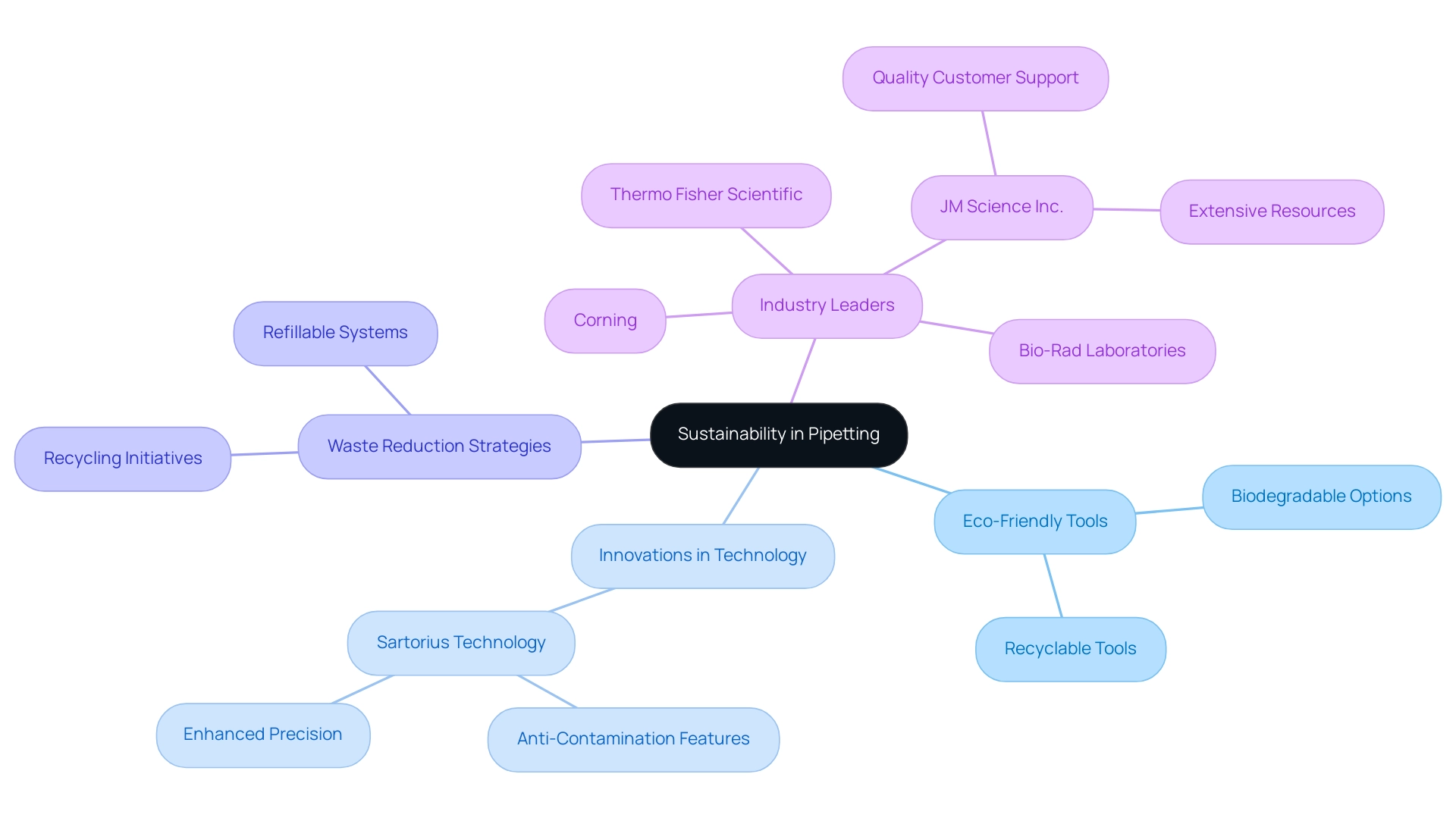
Key Features of High-Performance Pipette Tips for Accurate Results
High-performance laboratory tools, such as pipettes and tips, are engineered with essential characteristics that significantly enhance precision and reliability in laboratory environments. A precise fit with the instrument is vital; it prevents air leaks that can jeopardize measurement accuracy. Additionally, low retention surfaces are designed to minimize liquid loss during transfers, ensuring that the intended volume is delivered consistently.
Instruments manufactured to rigorous quality standards play a crucial role in ensuring reproducibility across experiments, which is fundamental for maintaining data integrity. For example, devices equipped with hydrophobic coatings have been demonstrated to improve the handling of viscous liquids, enabling precise dispensing every time. Recent studies reveal that the fit of liquid dispensers can directly influence measurement precision, with improper fittings resulting in discrepancies in results. Facilities that prioritize high-quality dispensing instruments, such as pipettes and tips, report a notable reduction in errors, underscoring the importance of investing in reliable liquid handling tools.
As the demand for precision in pharmaceutical research escalates—especially in light of rising healthcare expenditures, with U.S. health care spending increasing by 4.1% in 2022 to reach $4.5 trillion—this trend emphasizes the growing need for precision in pharmaceutical research and its implications for laboratory practices. Moreover, the Asia-Pacific region is experiencing rapid growth in the liquid handling products market, particularly regarding pipettes and tips, driven by increased research and healthcare funding. This trend further highlights the global significance of these instruments.
The liquid handling products market is also fueled by a rise in cancer and genetic disorder cases, making dependable fluid management tools like pipettes and tips indispensable in pharmaceutical laboratories. Major players in the pipette tips market, including Eppendorf, Thermo Fisher Scientific, and Sartorius Stedim Biotech, are strategically positioned to leverage this increasing demand. By focusing on features such as snug fit, low retention surfaces, and adherence to stringent manufacturing standards, facilities can markedly enhance their operational efficiency and the reliability of their results.
Best Practices for Effective Pipetting in Pharmaceutical Labs
To achieve optimal results in pharmaceutical laboratories, adhering to best practices for liquid handling is paramount, particularly the use of pipettes and tips. One of the most effective techniques is pre-wetting the pipette and tips before use. This practice significantly enhances accuracy by minimizing liquid retention, which can lead to discrepancies in measurements.
Research indicates that precision errors can be as low as 0.05% when proper techniques, such as pre-wetting, are employed. Maintaining a consistent liquid transfer angle and speed is equally important, as these factors greatly influence precision. Regular calibration of pipettes and tips is essential to ensure they function correctly, as the frequency of calibration directly impacts results. Laboratories should implement a robust calibration program, including thorough documentation and proper use of pipettes and tips, to comply with regulatory standards and enhance the reliability of their findings.
Training personnel on the correct techniques for using pipettes and tips for liquid transfer is crucial. This includes educating them on using the correct volume range and avoiding rapid dispensing, which can introduce errors. Practical instances show that thorough training initiatives significantly enhance accuracy in liquid handling with pipettes and tips, promoting a culture of excellence within the work environment.
As Ketan Rohom, Associate Director of Sales & Marketing, emphasizes, "Need more tailored information? Ketan is here to help you find exactly what you need."
Furthermore, industry leaders are encouraged to focus on digital transformation and streamline their product portfolios to meet changing requirements. Insights from the case study titled 'Strategic Recommendations for Industry Leaders' suggest that investing in research and development and diversifying distribution channels will be crucial for maintaining a competitive edge in the rapidly evolving calibration landscape.
In summary, by implementing these best practices for liquid handling with pipettes and tips, pharmaceutical labs can enhance operational efficiency and ensure the reliability of their results, ultimately contributing to improved patient care and outcomes. JM Science Inc. distinguishes itself through its commitment to quality, customer service, and innovation in scientific instruments, guaranteeing that research facilities have access to the finest tools for their liquid handling requirements.
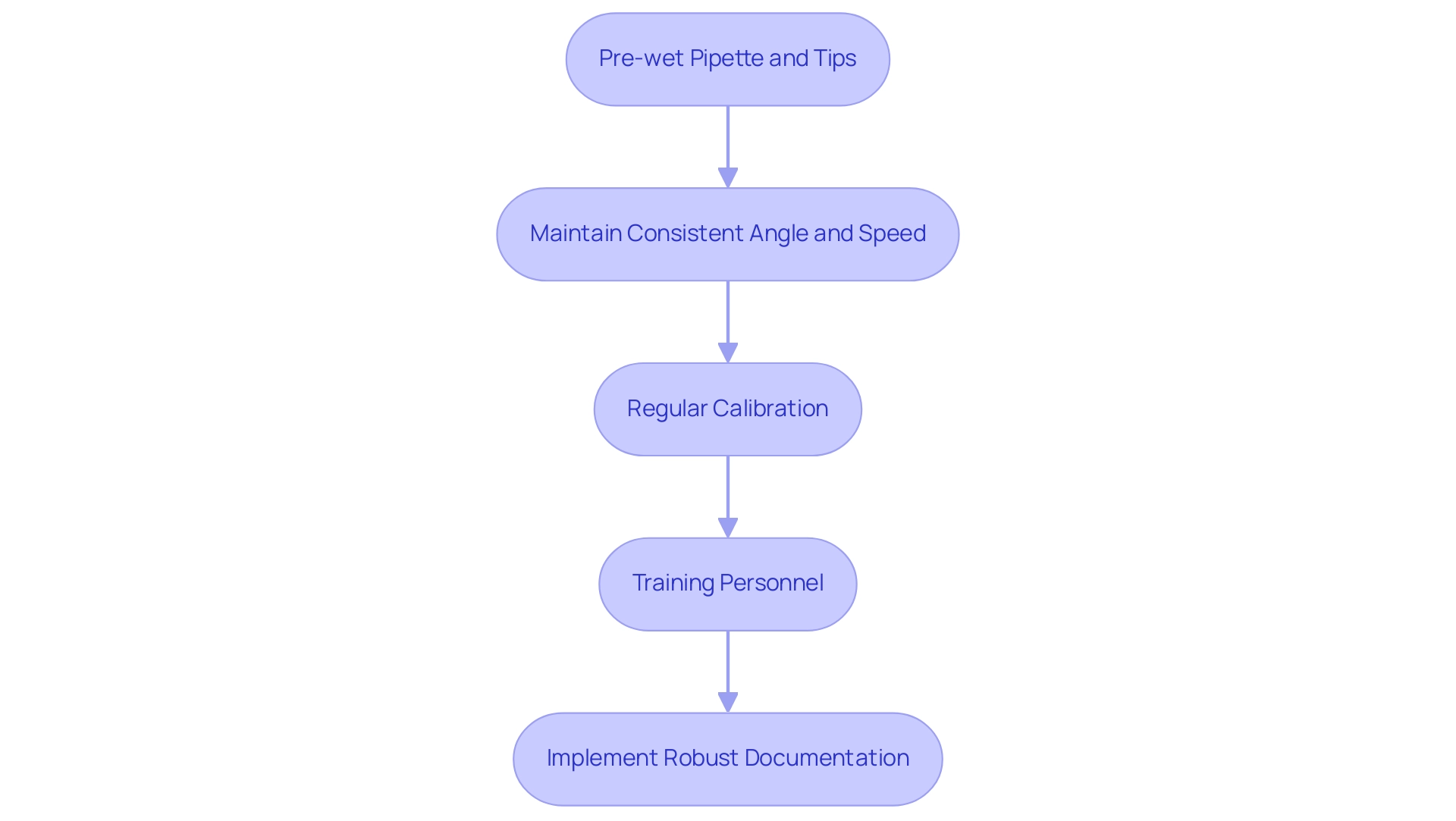
Overcoming Challenges in Pipetting: Solutions for Lab Managers
Pharmaceutical laboratories frequently encounter significant challenges related to pipettes and tips, particularly concerning variability in results and contamination risks. A prevalent issue arises from the improper selection of pipettes and tips, which can lead to inaccurate measurements and compromised data integrity. To combat this, lab managers must prioritize training for staff on the selection of appropriate pipettes and tips tailored to their specific applications, ensuring that the right tools are employed for each task.
Cross-contamination remains a critical concern, with statistics indicating that improper liquid handling practices have contributed to notable incidents in the industry. For instance, recent studies have highlighted that up to 75 million doses of Johnson & Johnson’s COVID-19 vaccine were discarded due to cross-contamination issues, underscoring the necessity for stringent protocols. Furthermore, the recall of up to 136 million bottles of pediatric medications by Johnson & Johnson illustrates the severe consequences of contamination and improper pipetting practices.
Implementing strict disposal protocols for used pipettes and tips, as well as utilizing filter tips when necessary, can significantly mitigate these risks. Regular maintenance and calibration of pipettes and tips are also vital to maintaining performance and accuracy. As Stephanie F. Mel noted, "Students will be able to explain how using a pipette incorrectly leads to errors," emphasizing the importance of proper techniques. A proactive approach to these challenges not only enhances the reliability of results but also ensures compliance with industry standards.
By adopting contamination prevention strategies and addressing variability in liquid handling, lab managers can safeguard the integrity of their work, ultimately contributing to the advancement of pharmaceutical research and development. Moreover, recent studies released by Galileo Defendi-Cho and Timothy M. Gould emphasize continuing advancements in the domain that pertain to liquid handling techniques and contamination prevention, further underscoring the necessity for alertness in research environments. The case study detailing metal contamination incidents involving Moderna and Johnson & Johnson serves as a stark reminder of the real-world implications of measurement errors and the necessity for stringent quality control measures.
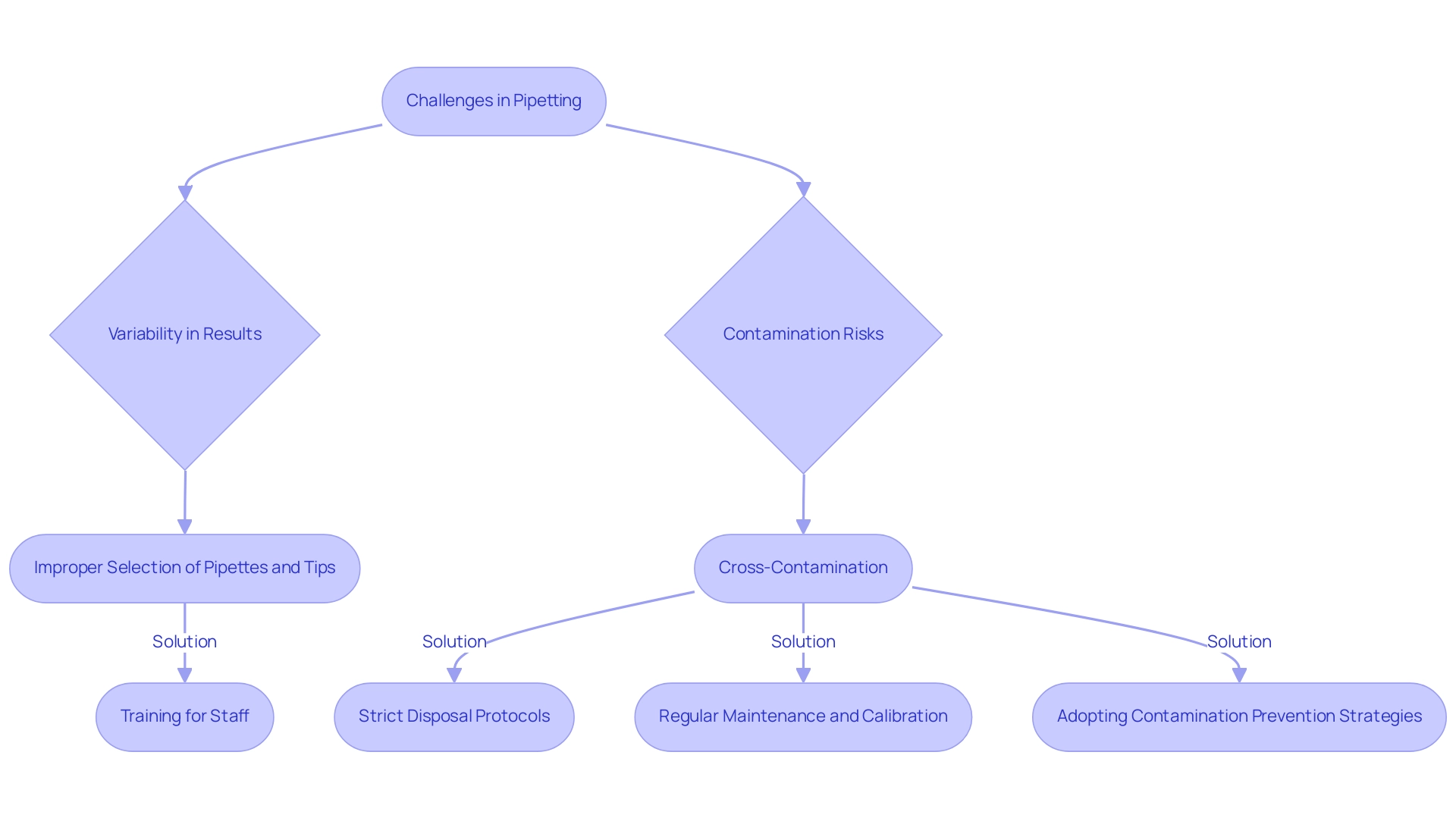
Training and Support: Empowering Lab Staff for Optimal Pipetting
Effective training programs are essential for ensuring laboratory staff achieve proficiency in liquid transfer techniques using pipettes and tips. Comprehensive training must encompass the fundamentals of liquid handling, including proper technique, equipment handling, and troubleshooting common issues associated with pipettes and tips. Regular workshops and refresher courses are vital for reinforcing these skills and keeping staff informed about best practices.
For instance, a recent initiative titled 'Pipette User Training with Individual Base-line Performance Evaluation' employed Transcat-certified pipette and tips standards to establish performance baselines for participants. This hands-on approach not only enhanced participants' understanding of their skills but also illuminated areas for improvement, underscoring the value of continued practice in achieving performance enhancements.
Moreover, providing access to resources such as instructional videos and manuals significantly supports staff development. These resources can lead to improved precision in liquid handling tasks, particularly when utilizing pipettes and tips, which is crucial in pharmaceutical settings where accuracy is paramount. Professional insights emphasize the importance of these teaching resources, indicating that they can greatly influence accuracy in liquid handling and overall efficiency in the workspace.
As Robert Houston Hamilton noted, maintaining precise conditions, such as temperature for reagents, is essential for accurate outcomes in experimental practices.
Additionally, incorporating personalized training sessions, such as the 20-minute, one-on-one personal training session from training experts, can further enhance the effectiveness of liquid handling training. Investing in comprehensive training not only enhances the competency of personnel but also contributes to the overall success of operations. As the landscape of testing procedures evolves, continuous education and advancement remain crucial for upholding high standards of precision and effectiveness in liquid handling tasks.
'JM Science Inc.'s commitment to quality and customer support underscores the significance of these training resources in the competitive arena of scientific practices.
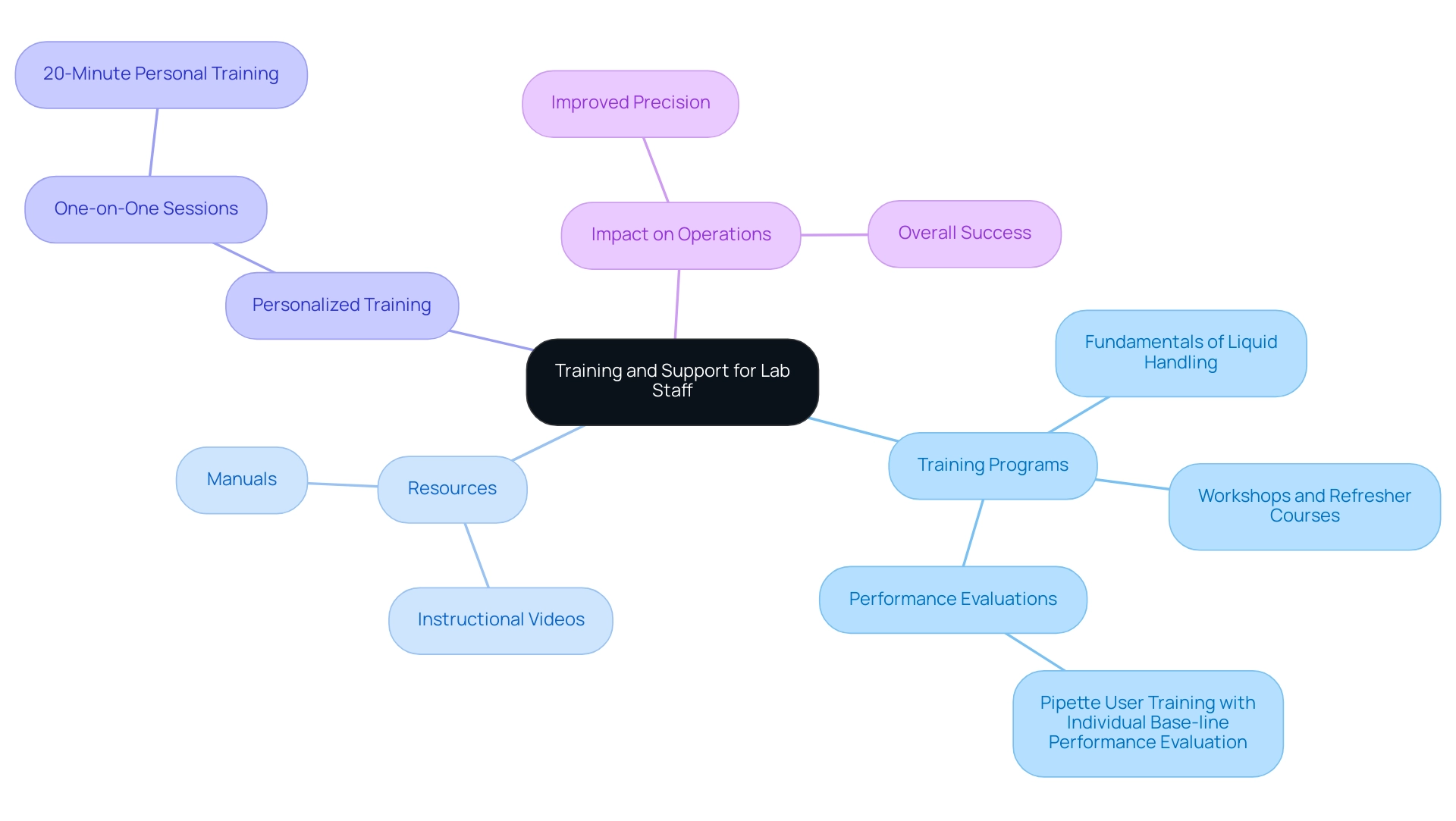
Future Trends in Pipetting Technology: Innovations on the Horizon
The future of liquid handling technology is poised for remarkable advancements, primarily driven by automation and smart technologies. Automated pipetting systems, utilizing pipettes and tips, are increasingly becoming essential in research facilities. These systems significantly enhance accuracy and efficiency while alleviating the physical strain on personnel. Recent innovations have led to the development of connected pipettes that seamlessly integrate with data management systems, streamlining workflows and improving data traceability.
As laboratories adopt these cutting-edge solutions, they position themselves to meet the evolving demands of pharmaceutical research. The adoption of automated liquid handling systems is projected to rise sharply, with a notable increase in market value fueled by the necessity for precision and reliability in experimental results. Recent statistics indicate a growing trend towards automation, with many labs reporting enhanced productivity and reduced error rates.
A significant indicator of this growth is Hamilton Co's recent award of a $128,162,524 contract to enhance its tip manufacturing capabilities, underscoring the market's investment in related technology.
Moreover, the introduction of large-volume pipettes and tips, such as those launched by GenFollower Biotech CO. LTD. in July 2024, exemplifies ongoing innovations aimed at improving laboratory efficiency and compatibility across various pipette brands. These advancements not only facilitate more efficient workflows but also align with sustainability goals by addressing environmental considerations associated with liquid handling systems, particularly the disposal of plastic consumables. A case study titled "Environmental Considerations in Pipette and Tips Systems" highlights the importance of sustainable practices in liquid handling, emphasizing the need for manufacturers to consider the environmental impact of their pipette and tips products.
Looking towards 2025, the integration of automation in pipetting systems is expected to profoundly impact pharmaceutical labs, enabling faster and more reliable results while supporting the industry's commitment to sustainability and efficiency. This relevance is underscored by the fact that U.S. health care spending increased by 4.1% in 2022, reaching $4.5 trillion, which highlights the importance of operational efficiency in laboratory practices.
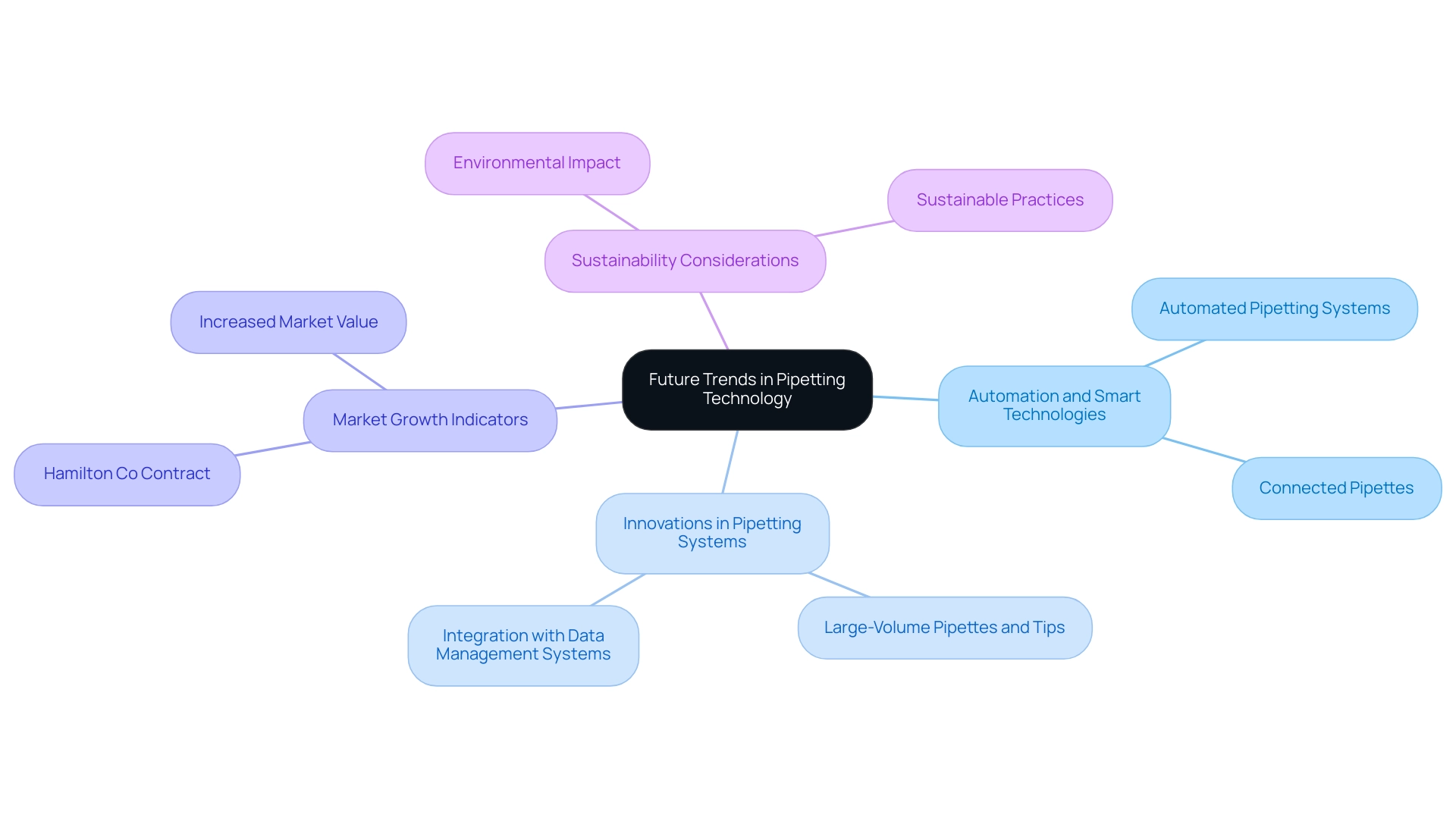
Conclusion
The significance of pipettes and their tips in pharmaceutical laboratories is paramount. These instruments are foundational for ensuring accuracy in liquid handling, which is critical for reliable experimental outcomes. As drug formulation becomes increasingly complex and stringent quality control is required, selecting high-quality pipettes and compatible tips is essential for minimizing errors and enhancing data integrity.
Recent advancements in pipette technology, such as the emergence of eco-friendly materials and automated systems, reflect a broader trend toward sustainability and efficiency in laboratory practices. The industry's growing preference for low-retention and filter tips underscores a commitment to improving precision while reducing waste. Moreover, ongoing training and adherence to best practices are vital for empowering laboratory staff and ensuring optimal pipetting techniques.
As the pharmaceutical sector continues to evolve, embracing innovative solutions will be crucial for maintaining a competitive advantage. The integration of automation and smart technologies promises to revolutionize pipetting processes, enabling laboratories to meet the increasing demands for accuracy and reliability in research. By prioritizing these advancements, pharmaceutical labs can enhance their operational efficiency and contribute to a more sustainable future for the industry.




